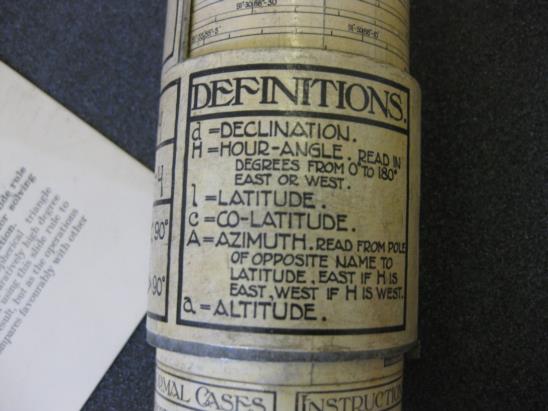
NavList:
A Community Devoted to the Preservation and Practice of Celestial Navigation and Other Methods of Traditional Wayfinding
Re: Precomputing sextant observations at sea
From: Gary LaPook
Date: 2014 Jan 29, 03:27 -0800
From: Gary LaPook
Date: 2014 Jan 29, 03:27 -0800
1. I think we would call the square boxs "estimated positions, EPs" not fixes. It is on the LOP and the position along the LOP was determined by dead reckoning.
2. The answer is simple. Azimuths calculated with the Bygrave are laid off from the pole opposite to the latitude. The computed azimuth is in the range of 0° to 180° and so must be laid off to both the east and to the west. Chichester used 31° S, 160° E for his AP and calculated the azimuth to be N 65 2/3° W (65° 40') and that is shown in the box on his chart. He also computed the Hc to be 27° 43'. I just did the calculation on my Bygrave reproduction and came up with EXACTLY the same answer. Since the LOP is at 90° from the azimuth he subtracted and got the answer of 24 1/3° which he added to south to arrive at the true course to Lord Howe, and then added in the variation. See annotated chart and photo of Bygrave instruction for laying off the azimuth.
gl
From: Francis Upchurch <francisupchurch@gmail.com>
To: garylapook@pacbell.net
Sent: Tuesday, January 28, 2014 11:18 PM
Subject: [NavList] Re: Precomputing sextant observations at sea
2. The answer is simple. Azimuths calculated with the Bygrave are laid off from the pole opposite to the latitude. The computed azimuth is in the range of 0° to 180° and so must be laid off to both the east and to the west. Chichester used 31° S, 160° E for his AP and calculated the azimuth to be N 65 2/3° W (65° 40') and that is shown in the box on his chart. He also computed the Hc to be 27° 43'. I just did the calculation on my Bygrave reproduction and came up with EXACTLY the same answer. Since the LOP is at 90° from the azimuth he subtracted and got the answer of 24 1/3° which he added to south to arrive at the true course to Lord Howe, and then added in the variation. See annotated chart and photo of Bygrave instruction for laying off the azimuth.
gl
From: Francis Upchurch <francisupchurch@gmail.com>
To: garylapook@pacbell.net
Sent: Tuesday, January 28, 2014 11:18 PM
Subject: [NavList] Re: Precomputing sextant observations at sea
Thanks Gary, yes I think I now understand how and why he did extra LOPs mid flight in addition to pre-flight pre-computed.. He needed more pre-computed LOPs for intermediate times like 0400GMT ?, some with new APs and therefore new Hcs via Bygrave?
The 2 remaining questions from the original chart are therefore:
1) how did he place his "square box fixes" along the new sun sight LOPs?
2) how did he calculate that final compass bearing at the turn off point to Howe Is? His pencil markings (bottom left) give bearing 193.3degs resulting from calculation 180+24.3=204.3,-11(?variation 11E?)=193.3degs, presumably magnetic? Where does the 24.3 degs come from?(combination of deviation,drift etc?) I think the -11degs is 11E variation,.I thought the true bearing would have been Az(68degs) +90deg=158deg true.
Anyways,fascinating stuff.
For my planned trip, the easiest approach looks to be simple graphs Hp & Az v time as you outlined.Although a short trip, I need 3 rock hopping waypoints where I need to miss the rocks by a mile and turn course, so I recon at least 3 LOPS..I'll show you the plan nearer the time.thanks again.I'll do the odd running fix as well ,just for fun.
----------------------------------------------------------------
NavList message boards and member settings: www.navlist.net/NavList
Members may optionally receive posts by email.
To cancel email delivery, send a message to NoMail[at]navlist.net
----------------------------------------------------------------
The 2 remaining questions from the original chart are therefore:
1) how did he place his "square box fixes" along the new sun sight LOPs?
2) how did he calculate that final compass bearing at the turn off point to Howe Is? His pencil markings (bottom left) give bearing 193.3degs resulting from calculation 180+24.3=204.3,-11(?variation 11E?)=193.3degs, presumably magnetic? Where does the 24.3 degs come from?(combination of deviation,drift etc?) I think the -11degs is 11E variation,.I thought the true bearing would have been Az(68degs) +90deg=158deg true.
Anyways,fascinating stuff.
For my planned trip, the easiest approach looks to be simple graphs Hp & Az v time as you outlined.Although a short trip, I need 3 rock hopping waypoints where I need to miss the rocks by a mile and turn course, so I recon at least 3 LOPS..I'll show you the plan nearer the time.thanks again.I'll do the odd running fix as well ,just for fun.
----------------------------------------------------------------
NavList message boards and member settings: www.navlist.net/NavList
Members may optionally receive posts by email.
To cancel email delivery, send a message to NoMail[at]navlist.net
----------------------------------------------------------------
: https://navlist.net/m2.aspx?i=126745








